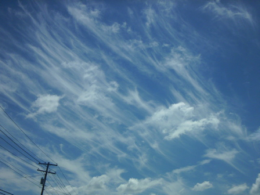Dust dries clouds by gobbling up water vapor: Scientists show how different cloud seeds can influence greenhouse effect

(Phys.org)—High in the atmosphere, cold and wispy cirrus clouds are the setting for a climate competition. Researchers at Pacific Northwest National Laboratory found that dust particles in the atmosphere can grab enough water vapor available to reduce the overall number of ice crystals formed in those clouds by other particles. Though somewhat scarce, the cloud-drying dust has an impact on Earth's incoming and outgoing energy that results in a net effect to cool the planet.
Unlike thick warm clouds that provide shade and cooling for the Earth, thin cirrus clouds act like an insulating blanket absorbing infrared light radiated from the Earth's warm surface. Scientists are working to better understand how particles such as dust affect these clouds. In this research, they found that dust particles act to reduce the overall number of ice crystals by competing for the water vapor in ice crystal formation. This results in a net cooling effect of Earth's climate. Their findings have implications for possible dust seeding of cirrus clouds to offset effects of global warming.
The team compared two ice nucleation parameterizations with differing dust efficiencies as ice nuclei in the Community Atmosphere Model version 5 (CAM5). The team tested how cirrus clouds react to dust ice nuclei in ice particle formation. Comparing the model simulations with site observations from aircraft data obtained in mid-latitudes, researchers found that dust ice nuclei may play an important role in the ice nucleation at these regions at super cold temperatures.
Cirrus clouds can be formed by the homogeneous freezing of sulfate solution droplets at temperatures lower than -37 degrees Celsius in conditions of high relative humidity. However, their findings show that cirrus clouds can also be formed by heterogeneous nucleation on dust particles, which produces larger ice crystals that settle down faster and dry out the cloud. These results highlight the importance of quantifying the number concentrations and properties of ice forming particles such as dust in the upper troposphere.
The team will continue to evaluate the representation of these clouds in CAM5 by comparing model results to field observations. With attention to the aerosols' effect on ice particle formation in these clouds, researchers will determine the role aerosols play to influence the Earth's energy budget and water cycle.
More information: Liu, X. et al. Sensitivity studies of dust ice nuclei effect on cirrus clouds with the Community Atmosphere Model CAM5. Atmospheric Chemistry and Physics 12, 12061-12079. DOI:10.5194/acp-12-12061-2012
Journal information: Atmospheric Chemistry and Physics
Provided by Pacific Northwest National Laboratory




















